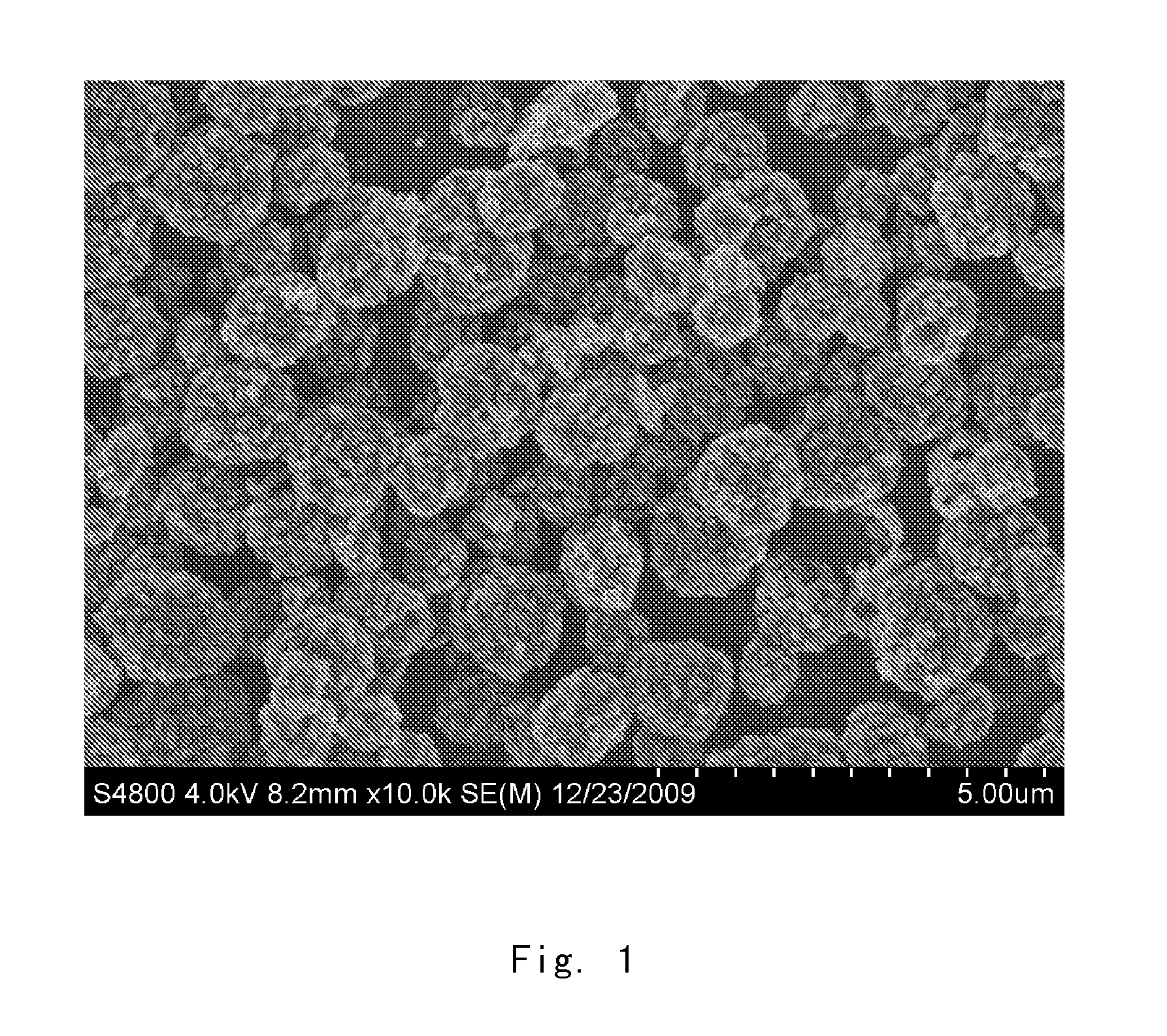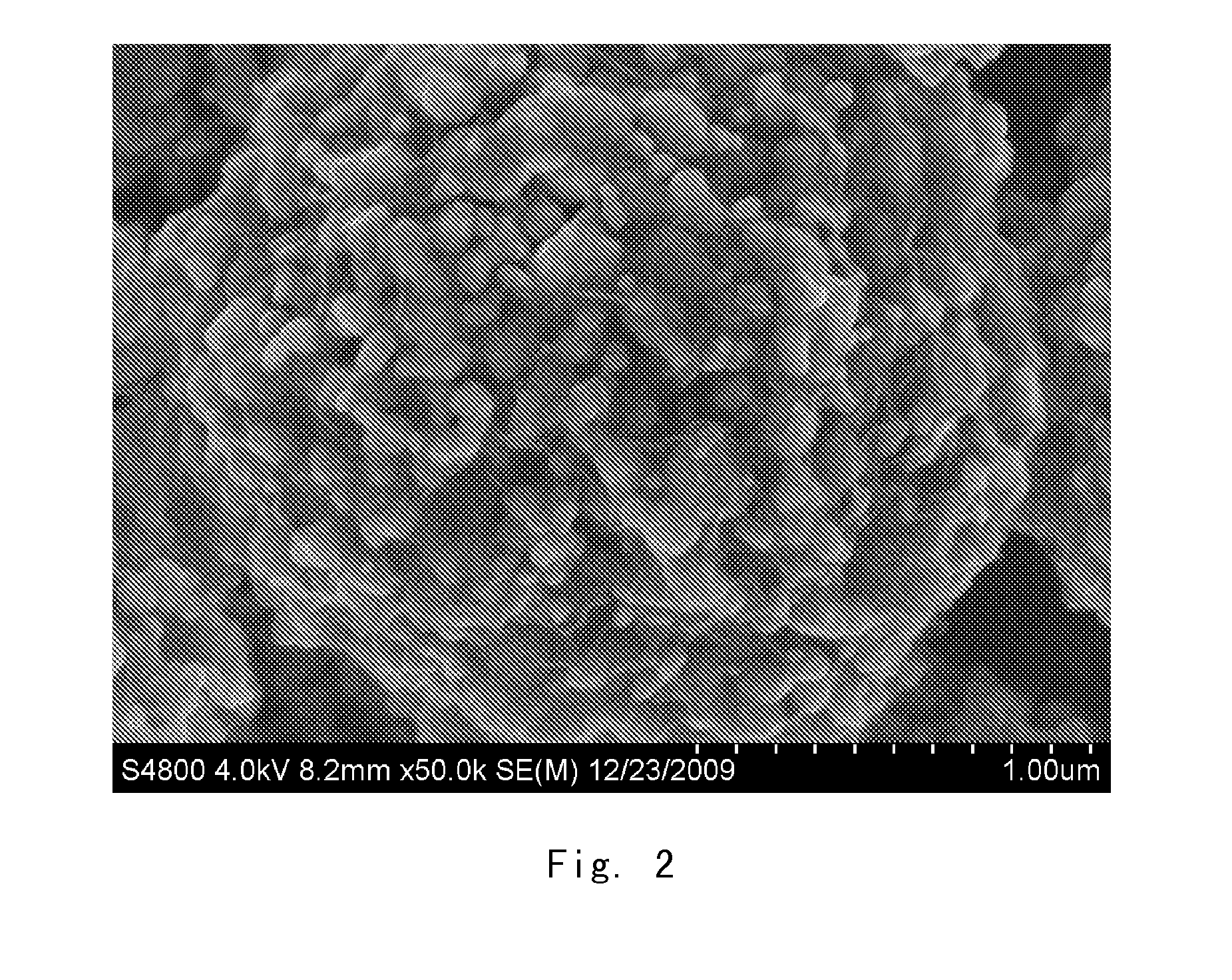Graphene-modified lithium iron phosphate positive electrode active material, preparation of the same and lithium-ion secondary cell
- Summary
- Abstract
- Description
- Claims
- Application Information
AI Technical Summary
Benefits of technology
Problems solved by technology
Method used
Image
Examples
example 1
[0037]In the first step, 1.2 g potassium nitrate was weighed and added into 46 ml concentrated sulfuric acid (96-98 wt. %), and then 1.0 g graphite was added. After mixing homogeneously, 6.0 g potassium permanganate was added slowly under agitation. Subsequently, the system was heated to 40° C., and agitation was continued for 6 hours. Then 80 ml water was added dropwise slowly. Meanwhile, the temperature of the system was raised to 70° C., and agitation was kept for 30 minutes. 200 ml water and 6 ml hydrogen peroxide (30%) were added, and agitation was stopped after 5 minutes. After the graphite oxide particles settled down, the supernatant was removed. This as-prepared product was washed several times with water until pH of the system reached 5 to obtain a mother liquor of the pure graphite oxide. The mother liquor of the graphite oxide was ultrasonicated for 2 hours to obtain a sol of the single-layer exfoliated graphene oxide.
[0038]In the second step, a stoichiometric amount of ...
example 2
[0041]The first step was carried out in the same way as that in Example 1 to obtain a graphene oxide sol.
[0042]In the second step, a stoichiometric amount of a ferrous salt (e.g. ferrous oxalate), a lithium salt (e.g. lithium chloride) and a phosphor source (e.g.
[0043]ammonium dihydrogen phosphate) was dissolved in water, and agitated at room temperature to form a homogeneous sol which was aged at raised temperature to obtain a gel. After drying, annealing treatment at high temperature (400-700° C.) was carried out under the protection of argon for 4-20 hours to obtain a lithium iron phosphate material.
[0044]The subsequent steps were the same as the third and fourth steps in Example 1.
example 3
[0045]The first step was carried out in the same way as that in Example 1 to obtain a graphene oxide sol.
[0046]In the second step, an iron source (e.g. ferrous oxalate, ferrous acetate, ferric oxide or ferric nitrate, etc.) was mixed stoichiometrically with a phosphor source (e.g. lithium dihydrogen phosphate, ammonium dihydrogen phosphate, or diammonium hydrogen phosphate, etc.) and a lithium source (e.g. lithium dihydrogen phosphate, lithium carbonate, lithium acetate, lithium nitrate, or lithium hydroxide, etc.), and ball milled to obtain a powder of reactant precursor. Annealing treatment at 400-700° C. was carried out under the protection of argon for 4-20 hours, and the product was ball milled at high speed to obtain a lithium iron phosphate powder.
[0047]The subsequent steps were the same as the third and fourth steps in Example 1.
PUM
| Property | Measurement | Unit |
|---|---|---|
| Temperature | aaaaa | aaaaa |
| Temperature | aaaaa | aaaaa |
| Time | aaaaa | aaaaa |
Abstract
Description
Claims
Application Information
 Login to View More
Login to View More - R&D
- Intellectual Property
- Life Sciences
- Materials
- Tech Scout
- Unparalleled Data Quality
- Higher Quality Content
- 60% Fewer Hallucinations
Browse by: Latest US Patents, China's latest patents, Technical Efficacy Thesaurus, Application Domain, Technology Topic, Popular Technical Reports.
© 2025 PatSnap. All rights reserved.Legal|Privacy policy|Modern Slavery Act Transparency Statement|Sitemap|About US| Contact US: help@patsnap.com



